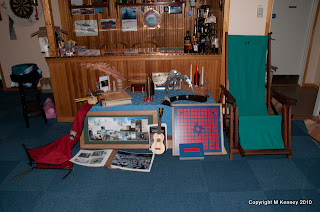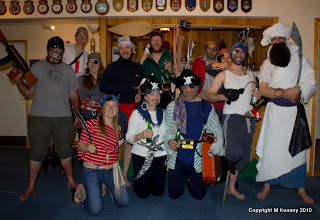Well, heres a surprise... What I do here is technically classed as work. It certainly takes up a minimum of 37.5 hours a week, and often quite a bit more, but I know trying to persuade you folks that this constitutes a 9-5 is like trying to persuade science that the Sun does in fact rotate around the Earth after all.
I would like to make a case for the work done here by saying firstly that it is not always glamorous, and South Georgia isnt always beautiful. Sometimes it rains heavily, and cold wind bites your cheeks as you meander your way to the boatshed to undertake some remedial works or get oily servicing an outboard engine. Only yesterday I was rota'd for "gash" during our weekly "scrubout". It was therefore my duty to empty all the bins, sort the recycling, clean the waste room, compact the cardboard, shred the glass and wash the gunge out of the landfill container.
So its not all fun and games after all, and although I am far from complaining about the down sides of the work here, I was thankful to get away for a short break.
Sue Gregory (Fisheries Biologist most-high) and I hitched a ride on the Ribs to Sorling on the Barff Peninsular.
Rookery bay is also on the Barff (see the blog) although Sorling is a few miles farther south, and significantly, is situated just on the East side of the Nordenskjold Glacier. From Sorling, it is possible to hike to St Andrews bay (known for its large colony of King Penguins), Ocean Harbour (know for being the site of the first whaling station on South Georgia, and the site of the remarkably intact wreck of the Bayard) and a few other worthwhile destinations on the oceanward East Coast.
Day one was spent organising camp at Sorling. The weather was iffy and forecast to get considerably worse, so taking some of Ray Mears' finest advice, we prepared food, warmth, a camp fire and some shelter.
 |
| The view of the Glacier from our Camp at Sorling. |
Day two was to be our first adventure East. We wanted to make Ocean Harbour and camp there for the evening with the hope of a spectacular sunrise over the Bayard the following morning. It was not to be. As we set off with full winter survival and camping kit weighing 30Kgs on our backs the weather began to deteriorate. Snow had fallen overnight and the atmosphere felt far more unsettled. Lenticular clouds over the mountain ranges warned of high winds in the hills and the visibility began to decay in the mist.
 |
| Showing the size of the packs. This was Sorling valley before the weather broke. |
The hike to Ocean is perhaps 2.5 miles as the crow flies, and initially it is a gentle climb up Sorling Valley, following the water course, which is a very picturesque river, reminiscent of the trout rivers of Scotland or the Salmon rich waterways of Canada. The route becomes slightly more challenging when a steep ascent is made to reach a Col to the South of "Black Peak" which takes you over the moutain range and drops you neatly in Ocean Harbour.
 |
| A King Penguin crossed a semi-frozen fast moving melt water stream near Sorling. |
Progress was good, and we were confident, despite the deepening snow as we climbed, that we would make camp in a few hours, however the weather took a rapid turn for the worse. We had been traversing the steep scree face with difficulty with heavy packs and deepening snow and ice for about 30 minutes when a large dark precipitous veil of cloud began to shroud the ridge we were heading for. The wind began to gust, and it became a little un nerving having to brace against 40mph wind with large slab sided packs and frozen snow under foot. It began to snow and we lost sight of the ridge to the West of our position. Already tired, and fearing that even if we made it to Ocean, this weather front may deposit far more snow and ice for the return journey, we decided to make back for Sorling. The decent back to the valley floor was a little unsteady, but far easier than climbing into the weather. It took us perhaps 2 hours walking to return safely to our camp at the Survival Hut. It was a good days walking, and we were both very pleased we had made an attempt. There was no regrets in our decision to abandon the hike as the temperature dropped, the snow fell and the winds continued to howl around the hut while we made soup over the Primus Stove.
 |
| The Reindeer stampede over the snowless lowland hills near Reindeer valley. |
Day 3 was a revelation. The initial plans to wake up on the shores of Ocean Harbour were scuppered but we awoke at Sorling to glorious sunshine, and a smattering of large Ice Bergs on the shore. As I mentioned earlier, Sorling is only a mile from the face of the Nordenskjold Glacier, and in the pitch black of night, tremendous rumbles and booms can be heard echoing around the bay as huge chunks of ice are deposited from the advancing face of the Glacier. This process, known as Calving, sets these large floating Ice Bergs adrift and often the larger ones end up grounded just offshore in the shallower water. It made for a spectacular compensation for the failings of the day before.
 |
| A large piece of Ice Calves from the Glacier Face. The noise is something to behold! |
We decided to make for the Glacier face and photograph some of the Calvings. It is, in comparison to the previous days effort, a very easy coastal walk, with light day sacks on our backs. We spent 3 hours at the Glacier, and I was pretty pleased with some of the images I shot. We had lunch sat amongst the ice on the shore, and witnessed some large calvings. I am pleased to report however, that the Nordenskjold did infact seem very stable, and although the pieces were large and spectacular, compared to the size of the face, the deposits are relatively small. I dont believe the Nordenskjold to be receding anywhere near the rate of the Neumayer or Hamburg Glaciers.
 |
| An evening return to camp from the Glacier. There were Gaint Petrels nesting very close to where this shot was taken. |
Day four, and the boats returned to take us back to base. It was our intention to stay until Monday (which would be day 5) however we decided to take advantage of the fact the boats were afloat to put the Government Officers aboard a fishing vessel for inspection in the bay. We did decide however to continue our holiday on our return and Monday morning we set off up Brown Mountain to the East of Gull Lake. This was Sue's first Summit, and despite a very sunny, if cold start at the bottom it became quite an adventure at altitude as the winds rose to 40 mph and the snow began to drift. We were well equipped and warmly dressed, so we had fun with it and ended up glissading (or bum sliding) down much of the mountain on our decent.
 |
| Sue poses for a snap near the summit of Brown Mountain. It is more akin to a long ridge that a typical mountain peak. |
Perhaps not well rested, but certainly very well rewarded for our travels, it is back to work. The base is encased in snow and Ice now, with the prospect of it getting quite abit worse, so we are preparing to begin having to dig our way out of doors every morning.... Ill keep you informed.
 |
| An idyllic Gull Lake on the way up Brown. |
 |
| The wind really blew on the South Ridge of Brown Mountain. |
 The Royal Air Force has finally succeeded in delivering some supplied for the OTEP project currently underway on the Barff and Busen peninsulas (blog update to follow)
The Royal Air Force has finally succeeded in delivering some supplied for the OTEP project currently underway on the Barff and Busen peninsulas (blog update to follow)




















































